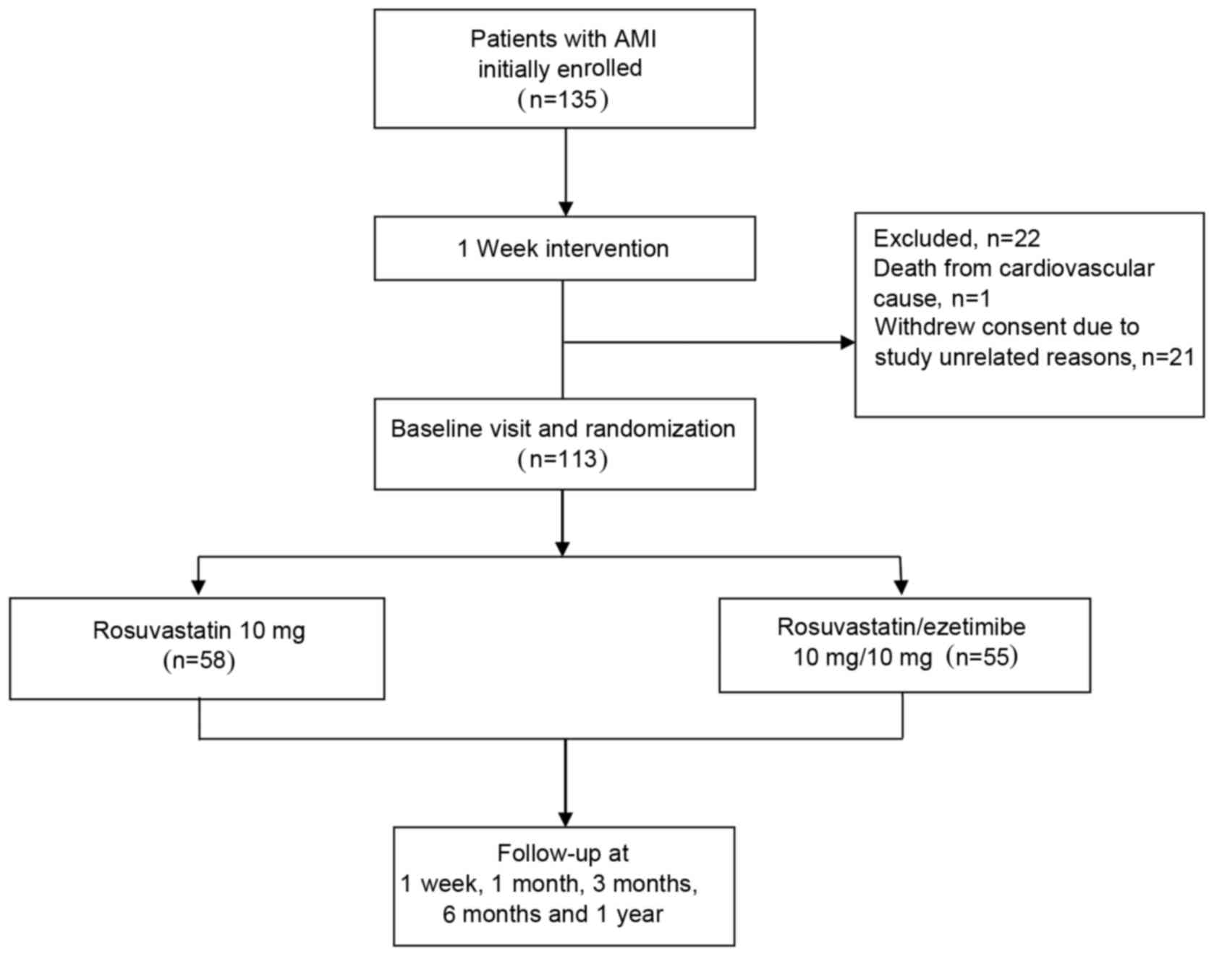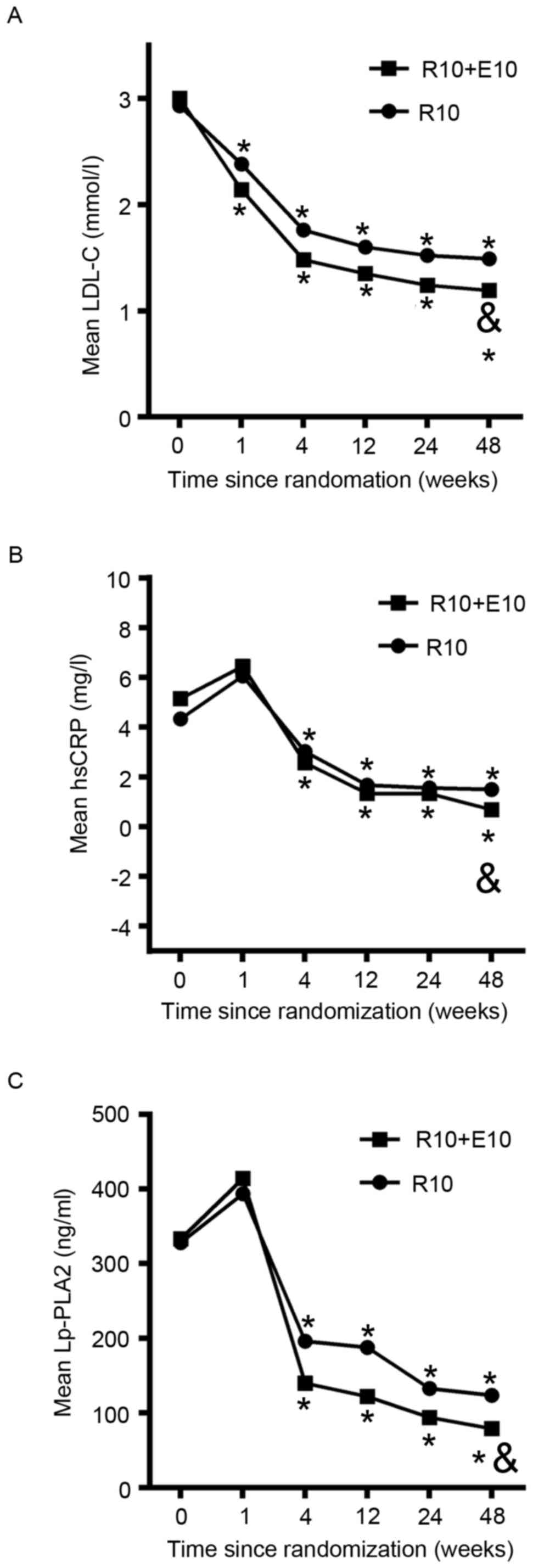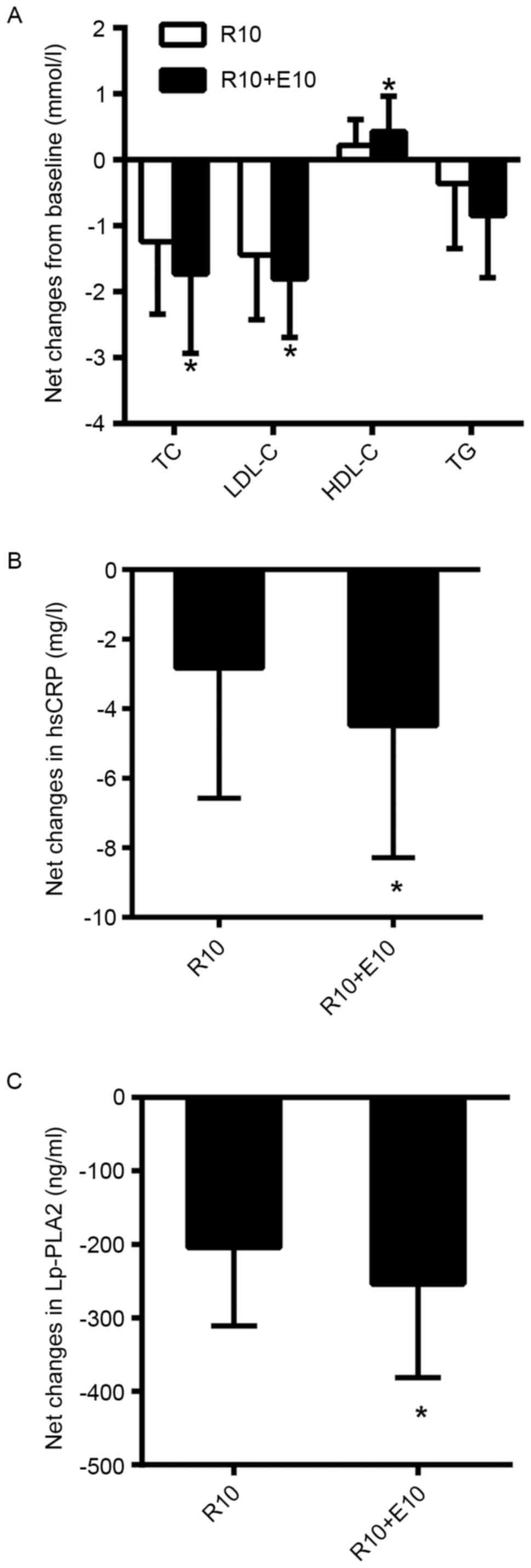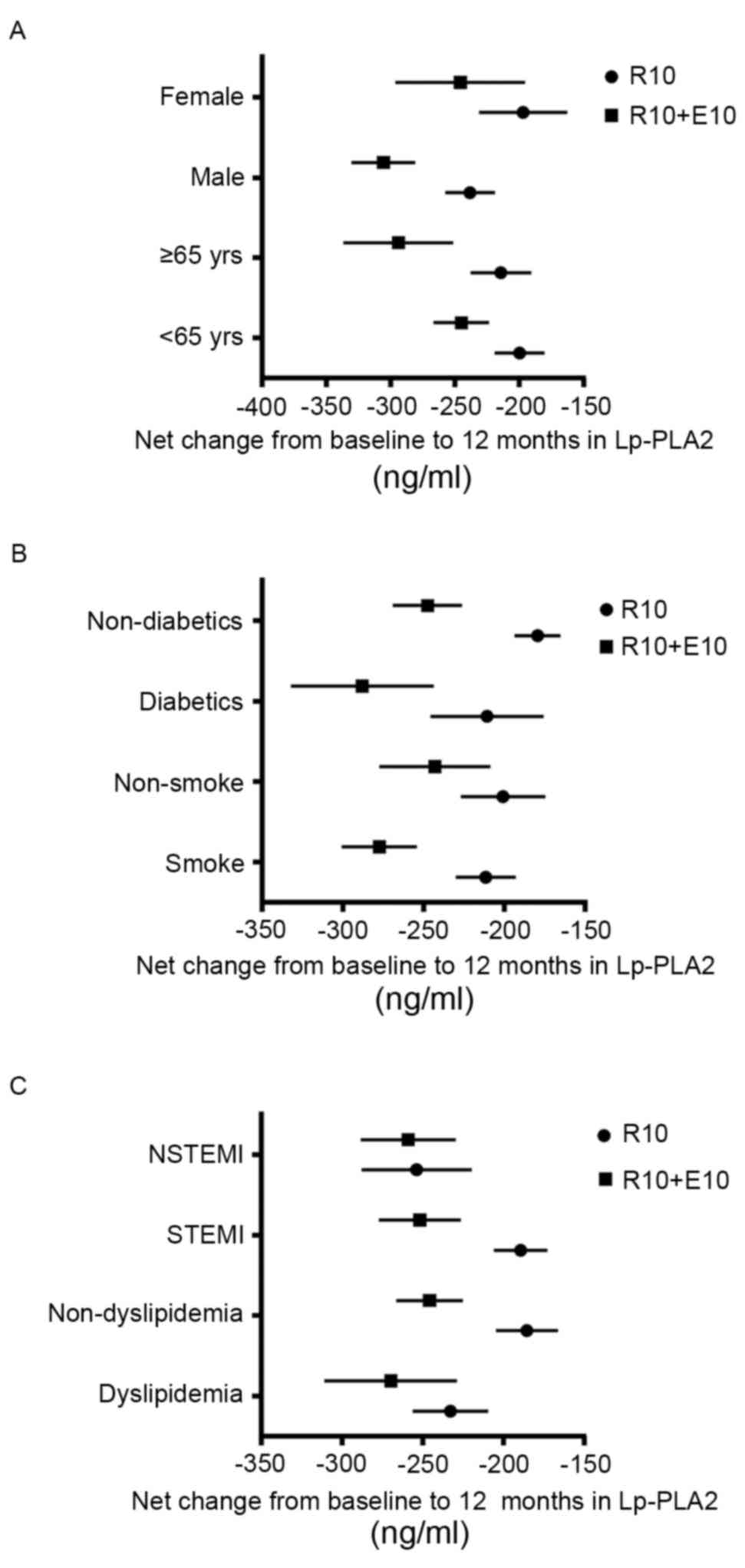|
1
|
Ross R: The pathogenesis of
atherosclerosis: A perspective for the 1990s. Nature. 362:801–809.
1993. View
Article : Google Scholar : PubMed/NCBI
|
|
2
|
de Lemos JA, Blazing MA, Wiviott SD, Lewis
EF, Fox KA, White HD, Rouleau JL, Pedersen TR, Gardner LH,
Mukherjee R, et al: Early intensive vs a delayed conservative
simvastatin strategy in patients with acute coronary syndromes:
Phase Z of the A to Z trial. JAMA. 292:1307–1316. 2004. View Article : Google Scholar : PubMed/NCBI
|
|
3
|
Ridker PM, Cannon CP, Morrow D, Rifai N,
Rose LM, McCabe CH, Pfeffer MA and Braunwald E: Pravastatin or
Atorvastatin Evaluation and Infection Therapy-Thrombolysis in
Myocardial Infarction 22 (PROVE IT-TIMI 22) Investigators:
C-reactive protein levels and outcomes after statin therapy. N Engl
J Med. 352:20–28. 2005. View Article : Google Scholar : PubMed/NCBI
|
|
4
|
Ridker PM, Danielson E, Fonseca FA, Genest
J, Gotto AM Jr, Kastelein JJ, Koenig W, Libby P, Lorenzatti AJ,
MacFadyen JG, et al: Rosuvastatin to prevent vascular events in men
and women with elevated C-reactive protein. N Engl J Med.
359:2195–2207. 2008. View Article : Google Scholar : PubMed/NCBI
|
|
5
|
Ballantyne CM, Blazing MA, King TR, Brady
WE and Palmisano J: Efficacy and safety of ezetimibe
co-administered with simvastatin compared with atorvastatin in
adults with hypercholesterolemia. Am J Cardiol. 93:1487–1494. 2004.
View Article : Google Scholar : PubMed/NCBI
|
|
6
|
Morrone D, Weintraub WS, Toth PP, Hanson
ME, Lowe RS, Lin J, Shah AK and Tershakovec AM: Lipid-altering
efficacy of ezetimibe plus statin and statin monotherapy and
identification of factors associated with treatment response: A
pooled analysis of over 21,000 subjects from 27 clinical trials.
Atherosclerosis. 223:251–261. 2012. View Article : Google Scholar : PubMed/NCBI
|
|
7
|
Pearson TA, Ballantyne CM, Veltri E, Shah
A, Bird S, Lin J, Rosenberg E and Tershakovec AM: Pooled analyses
of effects on C-reactive protein and low density lipoprotein
cholesterol in placebo-controlled trials of ezetimibe monotherapy
or ezetimibe added to baseline statin therapy. Am J Cardiol.
103:369–374. 2009. View Article : Google Scholar : PubMed/NCBI
|
|
8
|
Pearson T, Ballantyne C, Sisk C, Shah A,
Veltri E and Maccubbin D: Comparison of effects of
ezetimibe/simvastatin versus simvastatin versus atorvastatin in
reducing C-reactive protein and low-density lipoprotein cholesterol
levels. Am J Cardiol. 99:1706–1713. 2007. View Article : Google Scholar : PubMed/NCBI
|
|
9
|
Bohula EA, Giugliano RP, Cannon CP, Zhou
J, Murphy SA, White JA, Tershakovec AM, Blazing MA and Braunwald E:
Achievement of dual low-density lipoprotein cholesterol and
high-sensitivity C-reactive protein targets more frequent with the
addition of ezetimibe to simvastatin and associated with better
outcomes in IMPROVE-IT. Circulation. 132:1224–1233. 2015.
View Article : Google Scholar : PubMed/NCBI
|
|
10
|
Macphee CH, Nelson J and Zalewski A: Role
of lipoprotein-associated phospholipase A2 in atherosclerosis and
its potential as a therapeutic target. Curr Opin Pharmacol.
6:154–161. 2006. View Article : Google Scholar : PubMed/NCBI
|
|
11
|
Ragab SM, Safan MA, Obeid OM and Sherief
AS: Lipoprotein-associated phospholipase A2 (Lp-PLA2) and tumor
necrosis factor-alpha (TNF-α) and their relation to premature
atherosclerosis in β-thalassemia children. Hematology. 20:228–238.
2015. View Article : Google Scholar : PubMed/NCBI
|
|
12
|
Wilensky RL, Shi Y, Mohler ER III,
Hamamdzic D, Burgert ME, Li J, Postle A, Fenning RS, Bollinger JG,
Hoffman BE, et al: Inhibition of lipoprotein-associated
phospholipase A2 reduces complex coronary atherosclerotic plaque
development. Nat Med. 14:1059–1066. 2008. View Article : Google Scholar : PubMed/NCBI
|
|
13
|
Lp-PLA(2) Studies Collaboration; Thompson
A, Gao P, Orfei L, Watson S, Di Angelantonio E, Kaptoge S,
Ballantyne C, Cannon CP, Criqui M, et al: Lipoprotein-associated
phospholipase A(2) and risk of coronary disease, stroke, and
mortality: Collaborative analysis of 32 prospective studies.
Lancet. 375:1536–1544. 2010. View Article : Google Scholar : PubMed/NCBI
|
|
14
|
O'Donoghue M, Morrow DA, Sabatine MS,
Murphy SA, McCabe CH, Cannon CP and Braunwald E:
Lipoprotein-associated phospholipase A2 and its association with
cardiovascular outcomes in patients with acute coronary syndromes
in the PROVE IT-TIMI 22 (PRavastatin Or atorVastatin evaluation and
infection therapy-thrombolysis in myocardial infarction) trial.
Circulation. 113:1745–1752. 2006. View Article : Google Scholar : PubMed/NCBI
|
|
15
|
Albert MA, Glynn RJ, Wolfert RL and Ridker
PM: The effect of statin therapy on lipoprotein associated
phospholipase A2 levels. Atherosclerosis. 182:193–198. 2005.
View Article : Google Scholar : PubMed/NCBI
|
|
16
|
White HD, Simes J, Stewart RA, Blankenberg
S, Barnes EH, Marschner IC, Thompson P, West M, Zeller T, Colquhoun
DM, et al: Changes in lipoprotein-associated phospholipase A2
activity predict coronary events and partly account for the
treatment effect of pravastatin: Results from the long-term
intervention with pravastatin in ischemic disease study. J Am Heart
Assoc. 2:e0003602013. View Article : Google Scholar : PubMed/NCBI
|
|
17
|
Aydin MU, Aygul N, Altunkeser BB, Unlu A
and Taner A: Comparative effects of high-dose atorvastatin versus
moderate-dose rosuvastatin on lipid parameters, oxidized-LDL and
inflammatory markers in ST elevation myocardial infarction.
Atherosclerosis. 239:439–443. 2015. View Article : Google Scholar : PubMed/NCBI
|
|
18
|
Cannon CP, Blazing MA, Giugliano RP,
McCagg A, White JA, Theroux P, Darius H, Lewis BS, Ophuis TO,
Jukema JW, et al: Ezetimibe added to statin therapy after acute
coronary syndromes. N Engl J Med. 372:2387–2397. 2015. View Article : Google Scholar : PubMed/NCBI
|
|
19
|
Davidson MH, Ballantyne CM, Jacobson TA,
Bittner VA, Braun LT, Brown AS, Brown WV, Cromwell WC, Goldberg RB,
McKenney JM, et al: Clinical utility of inflammatory markers and
advanced lipoprotein testing: Advice from an expert panel of lipid
specialists. J Clin Lipidol. 5:338–367. 2011. View Article : Google Scholar : PubMed/NCBI
|
|
20
|
Ballantyne CM, Hoogeveen RC, Raya JL, Cain
VA, Palmer MK and Karlson BW: GRAVITY Study Investigators:
Efficacy, safety and effect on biomarkers related to cholesterol
and lipoprotein metabolism of rosuvastatin 10 or 20 mg plus
ezetimibe 10 mg vs. simvastatin 40 or 80 mg plus ezetimibe 10 mg in
high-risk patients: Results of the GRAVITY randomized study.
Atherosclerosis. 232:86–93. 2014. View Article : Google Scholar : PubMed/NCBI
|
|
21
|
Moutzouri E, Liberopoulos EN, Tellis CC,
Milionis HJ, Tselepis AD and Elisaf MS: Comparison of the effect of
simvastatin versus simvastatin/ezetimibe versus rosuvastatin on
markers of inflammation and oxidative stress in subjects with
hypercholesterolemia. Atherosclerosis. 231:8–14. 2013. View Article : Google Scholar : PubMed/NCBI
|
|
22
|
Le NA, Tomassini JE, Tershakovec AM, Neff
DR and Wilson PW: Effect of switching from statin monotherapy to
ezetimibe/simvastatin combination therapy compared with other
intensified lipid-lowering strategies on lipoprotein subclasses in
diabetic patients with symptomatic cardiovascular disease. J Am
Heart Assoc. 4:e0016752015. View Article : Google Scholar : PubMed/NCBI
|
|
23
|
Song JX, Ren JY and Chen H: Simvastatin
reduces lipoprotein-associated phospholipase A2 in
lipopolysaccharide-stimulated human monocyte-derived macrophages
through inhibition of the mevalonate-geranylgeranyl
pyrophosphate-RhoA-p38 mitogen-activated protein kinase pathway. J
Cardiovasc Pharmacol. 57:213–222. 2011. View Article : Google Scholar : PubMed/NCBI
|
|
24
|
Saougos VG, Tambaki AP, Kalogirou M,
Kostapanos M, Gazi IF, Wolfert RL, Elisaf M and Tselepis AD:
Differential effect of hypolipidemic drugs on
lipoprotein-associated phospholipase A2. Arterioscler Thromb Vasc
Biol. 27:2236–2243. 2007. View Article : Google Scholar : PubMed/NCBI
|
|
25
|
Zhang B, Fan P, Shimoji E, Itabe H, Miura
S, Uehara Y, Matsunaga A and Saku K: Modulating effects of
cholesterol feeding and simvastatin treatment on
platelet-activating factor acetylhydrolase activity and
lysophosphatidylcholine concentration. Atherosclerosis.
186:291–301. 2006. View Article : Google Scholar : PubMed/NCBI
|
|
26
|
Ostadal P, Vondrakova D, Kruger A, Janotka
M, Psotova H and Prucha M: Alteration in lipoprotein-associated
phospholipase A2 levels during acute coronary syndrome and its
relationship to standard biomarkers. Lipids Health Dis. 11:1532012.
View Article : Google Scholar : PubMed/NCBI
|
|
27
|
Li X, Kramer MC, Van der Loos CM, Koch KT,
de Boer OJ, Henriques JP, Baan J Jr, Vis MM, Piek JJ, Tijssen JG,
et al: A pattern of disperse plaque microcalcifications identifies
a subset of plaques with high inflammatory burden in patients with
acute myocardial infarction. Atherosclerosis. 218:83–89. 2011.
View Article : Google Scholar : PubMed/NCBI
|
|
28
|
Kawano Y, Narahara H and Johnston JM:
Inhibitory effect of interleukin-8 on the secretion of
platelet-activating factor acetylhydrolase by human decidual
macrophages. J Soc Gynecol Investig. 6:328–332. 1999. View Article : Google Scholar : PubMed/NCBI
|
|
29
|
Narahara H and Johnston JM: Effects of
endotoxins and cytokines on the secretion of platelet-activating
factor-acetylhydrolase by human decidual macrophages. Am J Obstet
Gynecol. 169:531–537. 1993. View Article : Google Scholar : PubMed/NCBI
|
|
30
|
Lin ZP, Shu PC, Liao ZJ, Wang XQ and Liu
Q: Rosuvastatin improves myocardial function and arteriosclerosis
plaque in patients with ST-segment elevation after acute myocardial
infarction and percutaneous coronary intervention. Nan Fang Yi Ke
Da Xue Xue Bao. 31:1789–1791. 2011.(In Chinese). PubMed/NCBI
|
|
31
|
Askevold ET, Gullestad L, Nymo S, Kjekshus
J, Yndestad A, Latini R, Cleland JG, McMurray JJ, Aukrust P and
Ueland T: Secreted frizzled related protein 3 in chronic heart
failure: Analysis from the controlled rosuvastatin multinational
trial in heart failure (CORONA). PLoS One. 10:e01339702015.
View Article : Google Scholar : PubMed/NCBI
|
|
32
|
James SK, Oldgren J, Lindbäck J, Johnston
N, Siegbahn A and Wallentin L: An acute inflammatory reaction
induced by myocardial damage is superimposed on a chronic
inflammation in unstable coronary artery disease. Am Heart J.
149:619–626. 2005. View Article : Google Scholar : PubMed/NCBI
|
|
33
|
Oldgren J, Wallentin L, Grip L, Linder R,
Nørgaard BL and Siegbahn A: Myocardial damage, inflammation and
thrombin inhibition in unstable coronary artery disease. Eur Heart
J. 24:86–93. 2003. View Article : Google Scholar : PubMed/NCBI
|
|
34
|
Elkind MS, Leon V, Moon YP, Paik MC and
Sacco RL: High-sensitivity C-reactive protein and
lipoprotein-associated phospholipase A2 stability before and after
stroke and myocardial infarction. Stroke. 40:3233–3237. 2009.
View Article : Google Scholar : PubMed/NCBI
|


















